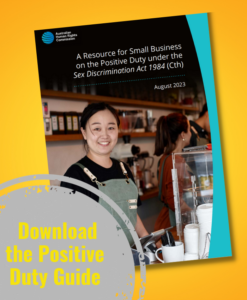In the dynamic landscape of workplace equality, the Australian Human Rights Commission (AHRC) has been at the forefront, responding to the urgent need for comprehensive measures to eliminate sexual harassment and discrimination.
Since December 2022, a legal obligation known as the positive duty has been in effect and included in the Sex Discrimination Act 1984 (Cth). This duty extends its reach to all persons conducting a business or undertaking (PCBUs), irrespective of their size, signaling a national commitment to fostering safe and inclusive workplaces.
What is a positive duty?
Employers are expected to work towards ending systemic behaviours by taking all reasonable measures to eliminate discrimination, sexual harassment or victimisation as far as possible, rather than simply taking action after the harmful behaviour has already occurred— this is a shift from a reactive to a proactive approach to sexual harassment.
Practical Steps for Compliance:
As an immediate step, employers can refer to the dedicated guide for small businesses provided by the Australian Human Rights Commission (AHRC).
To help organisations comply with the act, the AHRC has identified seven standards on which to focus:
- Leadership – Senior leaders must familiarise themselves with the positive duty requirements and exemplify the standards for equality and inclusion in their behavior.
- Culture – Employees must have a safe and respectful workplace culture and a risk-free means of reporting misconduct to leadership.
- Knowledge – Employers should publish inclusivity policies and educate employees on their rights and responsibilities.
- Risk management – A risk-based approach to SDA compliance should be applied, requiring all stakeholders to acknowledge and work to eliminate the health and safety hazards associated with workplace discrimination.
- Support – Employees must have access to counseling or other services should they experience or witness discriminatory conduct.
- Reporting and response – Employees must have well-communicated options for reporting unlawful conduct, and employers must respond in a manner that minimises harm to victims.
- Monitoring, evaluation and transparency – Employers are expected to collect data on workplace conduct and demonstrate that the data is used to improve workplace culture and prevent unlawful behaviour.
Additional Steps for Immediate Compliance:
To help prioritise and ensure compliance, the immediate steps the AHRC recommends for employers are to:
- Ensure the Leadership Team is Informed: Make sexual harassment and positive duty compliance standing agenda items at Board and Senior Leadership Management meetings.
- Consult and Engage with Workers: Regularly consult and engage with workers to discuss measures to eliminate potential sexual harassment risks and hazards, promoting a ‘speak up’ culture.
- Adopt a Work Health and Safety Approach: Take a work health and safety approach to sexual harassment by conducting regular risk assessments.
- Assess Policies and Training Programs: Assess policies and training programs to guarantee their effectiveness and alignment with the employer’s obligations. Ensure meaningful engagement from leadership and include all workers.
Additional Resources
- For a comprehensive understanding and immediate steps towards compliance, employers, especially in small businesses, can refer to the dedicated guide provided by the AHRC: Resource for Small Businesses on the Positive Duty.
- For further insights and updates on Respect@Work reforms, please explore our article: Further Updates on Gender Equality & Respect@Work Reforms.
- For additional information on the positive duty, you can visit the AHRC website.
Morrows – Empowering Your Path Forward
As your trusted advisors, we are committed to providing you with the necessary knowledge and resources to foster a workplace culture that prioritises respect and inclusivity. If you have any questions or need advice on any workplace legal matters, your advisor can connect you to Morrows Legal Solutions. Our employment lawyers will assist you in keeping up with these changes.
The advice in this article is general in nature and does not constitute legal advice.





